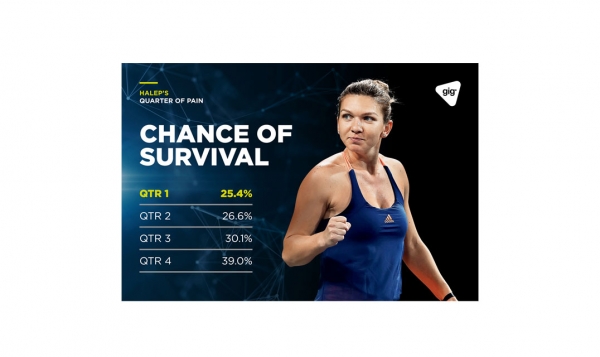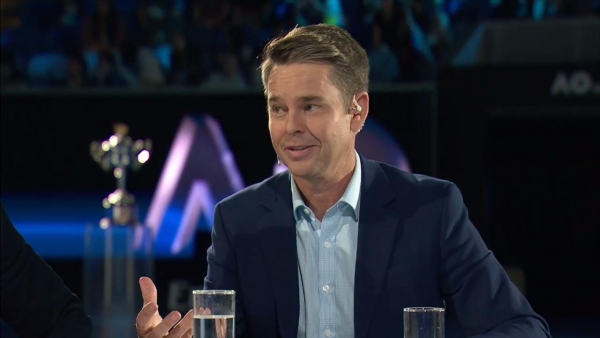No sooner had the Official Australian Open Draw Ceremony been completed than pundits and the press alike began declaring that Player X had a tough draw, or Player Y had an easier route to the final (guilty as charged – ed.).
But did any of those predictions have numbers to back them up? Or quantify the relative strength of the respective quarters?
Here at Tennis Australia’s Game Insight Group, we have tracked each player’s Elo rating throughout their career and used that to simulate the Australian Open 2018. We repeat the simulation 5,000 times to determine how the event is most likely to unfold on more statistically sound grounds – and the analysis revealed some interesting forecasts:
Roger Federer is expected to defend his title, despite his place in the toughest quarter in the men’s draw
The favourite for the women’s title following the draw is Elina Svitolina
Novak Djokovic has a statistically greater chance of victory than world No.1 and top seed Rafael Nadal

How did we arrive at these conclusions? First, we ignored the players’ rankings and compared them based on their Elo ratings.
Elo is a calculation of a player’s quality, capturing not only their win-loss record but the quality of those wins and the closeness of those losses by taking the opposition into account. While the ATP and WTA rankings award players points for tournament progression, the Elo rating captures who a player has beaten or lost to and weights the wins and losses accordingly.
GIG Elo ratings are also adjusted based on surface and for absences due to injuries – players who, for example, cut their 2017 season short are penalised as expectations for them are more pessimistic upon their return.
According to our research, an Elo of 2,000 is a good indicator that a player will to do well at a Grand Slam – we consider it a threshold for someone you can expect to go deep and potentially emerge from their quarter.
Following the draw, we assessed the prospects of each player based on their Elo and potential opposition. Each player’s Elo score heading into the first round was adjusted based on the simulated results in each subsequent round to determine their progress through the entire tournament. We then ran that simulation 5,000 times before taking a summary of the results.

And that summary gave us two statistically probable front-runners for each title. In the men’s draw, Roger Federer has a 38.9 per cent chance of defending his 2017 crown and claiming a record-equalling six Australian Open title. Meanwhile, Elina Svitolina has a 15.5 per cent chance of winning her maiden Grand Slam title, edging out top two seeds Simona Halep (12.8 per cent) and Caroline Wozniacki (10.6 per cent), who are also looking for their first majors.
Among the other title contenders: six-time former champion Novak Djokovic (20 per cent chance), top seed Rafael Nadal (8.4 per cent) and Juan Martin del Potro (7.1 per cent), with Grigor Dimitrov (4 per cent) and Nick Kyrgios (3.1 per cent) also in contention. Venus Williams is a leading contender for the women’s title (5.4 per cent), along with Caroline Garcia (4.7 per cent), Karolina Pliskova (4.4 per cent) and Madison Keys (4.1 per cent).
Our analysis goes far beyond the anticipated champions, however. GIG’s simulations also allowed us to identify the toughest quarters in each draw. In order to capture that, we took the player with the highest Elo rating per quarter and calculated the likelihood of each of them surviving all four quarters in the draw and averaging the results – essentially asking, what would happen if Federer was in Nadal’s spot in the draw, and Rafa in Roger’s?
Note that the players with the highest chance of emerging from their respective quarters as demonstrated by our 5,000 simulations are not necessarily the top four seeds. For the men, we analysed Roger Federer (Elo rating 2364), Novak Djokovic (2286), Rafael Nadal (2151) and Grigor Dimitrov (2103); for the women, we looked at Simona Halep (2229), Caroline Garcia (2145), Elina Svitolina (2241) and Caroline Wozniacki (2188).

In the men’s draw, it turns out that there is indeed a ‘quarter of pain’ – the fourth quarter, where Federer is the highest seed. What’s more, the difference in difficultly between the reigning champion’s quarter and that occupied by top seed Nadal is the most pronounced of the four sections: Q4 is 35 per cent tougher than Q1, 13 per cent tougher than Q2 and five per cent tougher than Q3.
What makes Federer’s quarter so difficult? A major reason is that there are two players, in addition to Federer, whose Elo rating is above 2,000 – David Goffin and Del Potro, who is considered among the four favourites for the title by our analysis. By contrast, the only other player to break the 2,000 barrier alongside Nadal in Q1 is Marin Cilic.
It’s much closer in the women’s draw. As the top seed, people might have expected Simona Halep to be the predicted champion – in fact, Elina Svitolina emerges as the most likely winner according to our simulations, in part due to Halep’s tougher quarter and the Ukrainian’s recent run in Brisbane. However, none of the leading contenders for the women’s title get near the 30 per cent probability threshold like Federer.
The draw has also been hard on Halep’s prospects. The world No.1 finds herself lands in the hardest quarter – a whopping 54 per cent tougher than Wozniacki’s Q4, 18 per cent tougher than Svitolina’s Q3 and five per cent tougher than Q2, occupied by Garcia.

Whether our predictions come to bear remains to be seen – we will find out in two weeks’ time – but our analysis speaks volumes about the luck of the draw at a Grand Slam tournament. Every player’s run to the final is unique, but some, we can now say with greater certainty, are harder than others.
Dr Stephanie Kovalchik is a Senior Data Scientist for the Tennis Australia Game Insight Group and Research Fellow in VU Institute of Sport, Exercise and Active Living.
The Game Insight Group (GIG) is an elite team of data, analytics and sport science experts headed up by former High Performance Manager Dr Machar Reid. In partnership with Victoria University, the team has one task – change the way players and fans engage in tennis. This includes improvements to tournament and prize money structure, racquet and string selection and developing a new way to describe a player’s performance.
